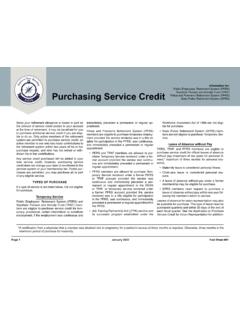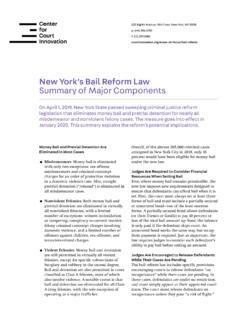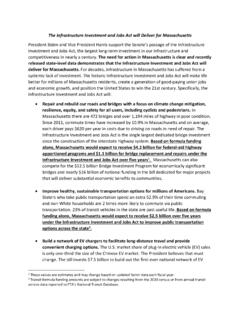Transcription of State Law Fact Sheet: A Summary of State Community …
1 State LAW fact sheet A Summary of State Community Health Worker L aw s Background Community health workers (CHWs), also known as Community health advocates, lay health educators, Community health representatives, promotores de salud, and various other terms, are Community members who work almost exclusively in Community settings and who serve as connectors between health care consumers and providers to promote health among groups that have traditionally lacked access to adequate health care. 1 Because CHWs live in the communities they serve, CHWs are uniquely qualified as connectors because they speak the language of their Community , know what is meaningful, and recognize cultural CHWs connect individuals to health services2,3 and educate providers about the unique needs of the Many interventions that integrate CHW services into health care delivery systems are associated with reductions in chronic illnesses,4 better medication adherence,4 increased patient involvement,5 improvements in overall Community health,6 and reduced health care.
2 8 One study of a CHW outreach program for underserved men found a return on investment ratio of more than $2 for each dollar Another study found an annual cost savings using CHWs of around $2,000 per Medicaid patient with A 2002 Institute of Medicine (IOM) report identified several barriers to the effective use of CHWs in multidisciplinary health care teams, including inconsistent CHW scopes of practice, training, and qualifications; sustainable funding mechanisms; and recognition by other health More recently, a 2010 IOM report recommended policy and systems changes to incorporate CHWs into local hypertension control State CHW Initiatives Rosenthal and colleagues examined two states comprehensive policy and systems changes designed to integrate CHWs into health care delivery One example of a comprehensive approach is the 2006 Massachusetts Health Care Reform Law directive to the Department of Public Health (DPH)
3 To conduct a study on the uses of and funding for CHWs and provide recommendations for creating a sustainable CHW program. In response, DPH established a CHW advisory council to review existing research, conduct statewide focus groups, and partner with the University of Massachusetts Medical School to survey This research culminated in the 2009 report Community Health Workers in Massachusetts: Improving Health Care and Public The report identified four areas in which DPH and partner organizations could act to develop a sustainable CHW program: infrastructure, professional identity, workforce development, and financing (see Table 1).
4 12 The report also proposed recommendations in each area. To understand how states are using law as a tool to develop sustainable CHW programs, this fact sheet summarizes the extent to which states have enacted laws addressing CHW infrastructure, professional identity, workforce development, and financing. Table 1: Select Recommendations from Community Health Workers in Massachusetts12 Infrastructure Establish a CHW advisory body to assist with the development and implementation of a sustainable program. Professional Identity Encourage the adoption of the term Community health worker, a unified definition of CHW core competencies, and a common scope of practice.
5 I ntegrate the role of CHWs into training for health care providers. Workforce Development Develop statewide infrastructure for CHW training and education. D evelop a CHW certification process and training curriculum, including defined core competencies and skills. Require continuing education and recertification. Financing Include CHW services in Medicaid administrative cost claims. Integrate CHWs into managed or team-based care models. Increase and sustain grant funding for outreach. Provide incentives for private insurers to use CHWs. This fact sheet presents a Summary of laws in effect as of December 2012 and is not intended to promote any particular legislative, regulatory or other action.
6 Learn more about State Law fact Sheets at 2 Data Collection The research team collected and reviewed laws (statutes, legislation, and regulations) in the 50 states and District of Columbia that were in effect as of December 31, 2012. The team used two search engines: Westlaw (Thomson Reuters, Eagan, Minnesota) and State Net (LexisNexis, Sacramento, California). Findings were cross-referenced with Internet legislative and administrative code sites for each jurisdiction. Search terms included Community health worker and 23 alternate terms identified by subject matter experts. Laws were coded according to the level of authority specified ( , required, authorized, or prohibited).
7 State Laws As of December 31, 2012, 15 states and the District of Columbia had enacted laws addressing CHW infrastructure, professional identity, workforce development, or financing (see Figure 1 and Table 2). Six State legislatures created an advisory body or ordered a study to investigate the impact of CHWs on achieving health care savings or eliminating health disparities. Following release of these studies, Massachusetts and Oregon enacted additional laws to regulate CHWs. Of eight states that codify a CHW scope of practice, three specify a role for CHWs in chronic disease prevention and care.
8 For example, Rhode Island established the Commission of Health Advocacy and Equity in 2011, which engages CHWs to reduce disparities in disease prevention, chronic diseases, and family services. Five states have enacted workforce development laws that create a certification process or require CHWs to be certified. Six states authorize the creation of standardized curricula on the basis of core competencies and skills, and four of those states authorized a certification board to set education requirements and oversee the certification process. Seven states have laws authorizing Medicaid reimbursement for some CHW services.
9 No State requires CHW coverage by private insurers. Some states , such as Texas, grant the authority to explore CHW reimbursement mechanisms to a commission. In 2012, as part of an effort to address health disparities, Maryland authorized the creation of health enterprise zones in which CHWs and their employers are eligible for tax incentives. Seven states have enacted laws to encourage or require the integration of CHWs into team-based care models for at least some health care organizations or services. Implications The scientific evidence base demonstrates the value of CHW services to improve health care outcomes and reduce costs.
10 This evidence supports State initiatives to incorporate CHWs into the health care delivery system. As states examine strategies to improve health outcomes, reduce health care costs, and reduce health inequities, they can consider using law as a tool to establish sustainable CHW programs, to include creating supportive infrastructure, addressing professional identity, and developing workforce and financing mechanisms. DC At least one provision concerning CHWs enacted CHW certification or training process authorized or required Figure 1: states with Select CHW Laws in Effect, December 2012 -3 Table 2.

















